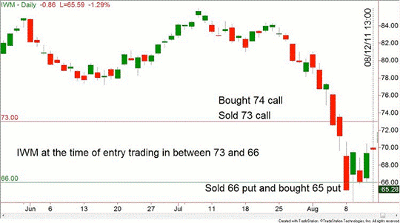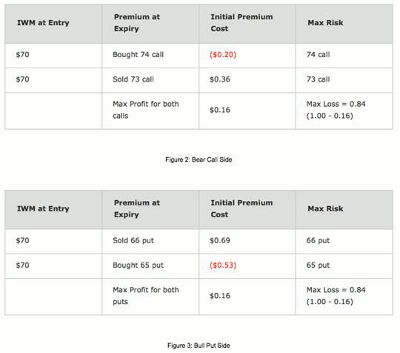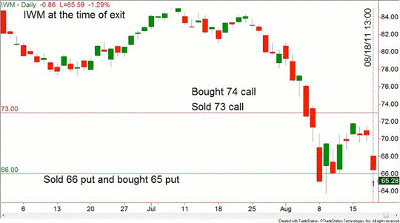Trades can go awry for any number of reasons, and those who take responsibility and swift, appropriate action to manage their position will be better able to secure profits and/or limit losses.
When an option trade goes wrong, a trader is presented with two choices:
- Take responsibility for the trade going against their initial plan, or…
- Attempt to pass the responsibility onto someone else.
The usual complaints I hear from traders are any of the following: The platform did not work properly; the stock market is unstable; or the individual stock had unexpected news come out without any warning.
A professional trader must be fully accountable for every single trade that is placed. Achieving that level of accountability is connected with pre-planning all the possible outcomes beforehand.
Now, having said that, let us look at a trade in which I initially did not think I would need to do anything after the entry. The trade did not have any directional bias because price action was channeling in between two levels. I used the option strategy known as an iron condor, expecting the price to remain bound within its confines.
See video: The Basics of Iron Condor Options
The iron condor strategy involves placing two short vertical spreads on a sideways-moving stock and basically waiting for option expiry. The profitability of the trade rests in the fact that it is basically Delta neutral and money is made through the time decay of the option premium.
The iron condor is a directionless strategy in which the expectation is made that the underlying is going to stay traveling sideways for the time being. As with any trade, there are two dimensions involved: Time and price.
Without getting too deep into the intricacies of the iron condor, I will just focus on the bottom-line dimensions of time and price. Any stock market chart is composed of two components, the vertical axis, which displays the price; and the horizontal axis, which displays time.
This trade was placed on the iShares Russell 2000 Index Fund (IWM).
Vertical Component: Price
At the time of my entry, IWM was trading around $70, with the immediate level of resistance around $73 and support at $66. I placed the iron condor involving those exact levels.
The 66 put was sold and the 73 call was also sold. Hence, as long as the IWM stayed in between $66 and $73, the option premium would decay and the trade would be profitable. The 65 put and the 74 call were bought to limit potential loss.
NEXT: Horizontal Component: Time
|pagebreak|Horizontal Component: Time
How long could IWM continue going sideways is the question that needs to be answered prior to trade entry. Of course, there is no certainty in that, and that’s why many traders turn toward technical analysis for help. The daily chart below shows IWM at the time of entry.
Clear zones of support and resistance were there at the time of entry and my line of thinking, in hindsight, was that after a volatile week, the stock market would calm down for at least a few days and stay flat.
With that frame of mind, I placed ten contracts on this small iron condor trade. The goal was to exit when about 80% of the maximum profit was achieved. In this particular trade, the max profit was $32, so 80% of that would be around $26. By the way, the risk for the entire iron condor was only $68.
The specifics below show the iron condor as two verticals, each with a max profit of $16, which are to be added together for the total possible profit.
After the entry, the trade stayed price-bound for the first several days, but then my mindset changed due to unforeseen news coming out from all over the world. I chose to exit my directionless trade in the least-painful way by buying back my obligations. Namely, the sold 73 call and the 66 put were closed while the long (65 put and 74 call) legs were left (untouched) to expire worthless.
The main reason I exited was due to the possibility that the market might move significantly out of the $66-$73 range. At the time of the exit, each side of my trade had made me some profit, but the total was not 80% of the max profit, as was my aim.
On the bear call side, there was $11 made out of a possible $16, and on the bull put side, only $9 out of a possible $16. Together, $20 ($11+$9) was made out of the possible aggregate of $32 for the entire iron condor.
The very next day, after the exit was made, the market dropped rapidly, and one of the legs that was left to expire worthless had gained in value due to the significant market drop. On the chart above (Figure 4), a blue arrow is placed below the spot where price went the lowest. The long 65 put, which was initially out-of-the-money protecting the sold 66 put became valuable due to the price drop.
IWM fell through the $66 support and was nearing the $65 zone; hence, the 65 put had increased in value to $49. None of that $65 put value was intrinsic, so I knew that it would go away within a matter of hours. The logical thing to do was to close the 65 put by selling to close. Due to the additional income of $49, the entire profit/loss calculation had changed.
The bottom line: Be totally accountable for your actions; if the trade does not do what was initially expected for whatever reason, be flexible and adapt to the current situation.
It does take courage to be accountable because full accountability is not always the most popular choice, but when trading, that is the only road a trader can take.
By Josip Causic, instructor, Online Trading Academy

























